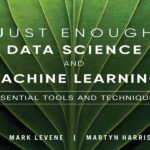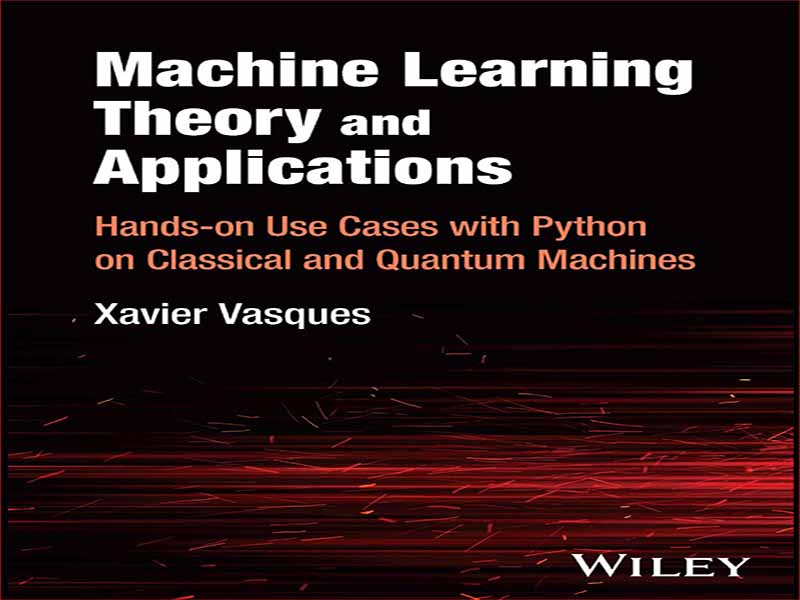- عنوان کتاب: Machine Learning Theory and Applications
- نویسنده: Xavier Vasques
- حوزه: یادگیری ماشین
- سال انتشار: 2024
- تعداد صفحه: 510
- زبان اصلی: انگلیسی
- نوع فایل: pdf
- حجم فایل: 138.8 مگابایت
در این کتاب، قرار نیست فلسفه ورزی کنیم، اما چگونگی به کارگیری یادگیری ماشین را به طور ملموس بررسی خواهیم کرد. یادگیری ماشینی زیرشاخهای از هوش مصنوعی است که هدف آن درک ساختار دادهها و تطبیق آن دادهها در مدلهایی است که میتوانیم برای برنامههای مختلف استفاده کنیم. از زمان خوشبینی دهه 1950، زیرمجموعههای کوچکتر هوش مصنوعی مانند یادگیری ماشینی و به دنبال آن یادگیری عمیق، کاربردهای ملموستر و اختلالات بزرگتری را در اقتصاد و زندگی ما ایجاد کردهاند. یادگیری ماشینی یک زمینه بسیار فعال است، و باید برخی از ملاحظات را در نظر داشت. این فناوری در همه جا از کارهای خودکار گرفته تا ارائه بینش هوشمند استفاده می شود. این به هر صنعتی مربوط می شود و تقریباً مطمئناً بدون اطلاع از برنامه های هوش مصنوعی استفاده می کنید. ما میتوانیم پیشبینی کنیم، تصاویر و گفتار را تشخیص دهیم، تشخیصهای پزشکی انجام دهیم، زنجیرههای تامین هوشمند ابداع کنیم و خیلی چیزهای دیگر. در این کتاب، روشهای رایج یادگیری ماشین را بررسی میکنیم. انتظار میرود خواننده برنامهنویسی پایتون و کتابخانههایی مانند NumPy یا Pandas را درک کند. ما نحوه آماده سازی داده ها را قبل از تغذیه مدل ها با نشان دادن ریاضیات و کد با استفاده از چارچوب های منبع باز شناخته شده مطالعه خواهیم کرد. ما همچنین یاد خواهیم گرفت که چگونه این مدل ها را نه تنها بر روی رایانه های کلاسیک (مبتنی بر CPU یا GPU) بلکه در رایانه های کوانتومی نیز اجرا کنیم. همچنین مفاهیم اساسی ریاضی در مدل های یادگیری ماشین را یاد خواهیم گرفت. یکی از گامهای مهم در سفر ما به سمت هوش مصنوعی این است که چگونه مدلهایی را که آموزش دادهایم وارد تولید کنیم. بهترین شرکتهای هوش مصنوعی مراکز داده را برای سادهسازی دسترسی به دادههای کنترلشده، نظارت شده و با کیفیت بالا ایجاد کردهاند. این دادهها برای هر کاربری که مجاز است، بدون توجه به اینکه دادهها یا کاربر در کجا قرار دارد، قابل دسترسی است. این یک نوع معماری سلف سرویس برای مصرف داده است. دلیل اینکه ما باید مفهوم هاب داده را در نظر بگیریم این است که ما در دنیایی از شرکتهایی هستیم که دارای چندین ابر عمومی، محیطهای داخلی، ابرهای خصوصی، ابرهای ترکیبی، ابرهای توزیعشده و دیگر پلتفرمها هستند. درک این جهان یک تمایز کلیدی برای یک دانشمند داده است. این همان چیزی است که ما آن را حاکمیت داده می نامیم، که برای یک سازمان بسیار مهم است اگر واقعاً بخواهد از هوش مصنوعی بهره مند شود. چقدر زمان صرف بازیابی داده ها می کنیم؟ موضوع مهم دیگر در مورد هوش مصنوعی این است که چگونه مطمئن شویم مدل هایی که توسعه می دهیم قابل اعتماد هستند. از آنجایی که انسان ها و سیستم های هوش مصنوعی به طور فزاینده ای با هم کار می کنند، ضروری است که به خروجی این سیستم ها اعتماد کنیم. به عنوان دانشمندان یا مهندسان، باید بر روی تعریف ابعاد هوش مصنوعی قابل اعتماد، تشریح رویکردهای متنوع برای دستیابی به ابعاد مختلف، و تعیین نحوه ادغام آنها در کل چرخه حیات یک برنامه هوش مصنوعی کار کنیم. موضوع اخلاق هوش مصنوعی مورد توجه گسترده رسانه ها، صنعت، دانشگاه و دولت قرار گرفته است. یک سیستم هوش مصنوعی به خودی خود مغرضانه نیست، بلکه به سادگی از هر آنچه که داده به آن یاد می دهد، یاد می گیرد. به عنوان نمونه ای از سوگیری آشکار، تحقیقات اخیر نرخ خطای قابل توجهی بالاتری را در طبقه بندی تصاویر برای زنان با پوست تیره نسبت به مردان یا سایر رنگ های پوست نشان داده است. هنگامی که ما یک خط کد می نویسیم، وظیفه و مسئولیت ما این است که مطمئن شویم قبل از تولید چیزی، سوگیری ناخواسته در مجموعه داده ها و مدل های یادگیری ماشین ظاهر نمی شود و پیش بینی می شود. ما نمی توانیم نادیده بگیریم که مدل های یادگیری ماشین به طور فزاینده ای برای اطلاع رسانی تصمیمات پرمخاطره در مورد افراد واقعی مورد استفاده قرار می گیرند. اگرچه یادگیری ماشین، به دلیل ماهیت خود، همیشه نوعی تبعیض آماری است، این تبعیض زمانی قابل اعتراض است که گروههای ممتاز خاصی را در مزیت سیستماتیک و گروههای غیرمجاز خاص را در مضیقه سیستماتیک قرار دهد. سوگیری در دادههای آموزشی، به دلیل سوگیری در برچسبها یا نمونهگیری کم یا بیش از حد، مدلهایی با نتایج نامطلوب به همراه دارد. من معتقدم که اکثر مردم به طور فزاینده ای به حقوق در محیط کار، دسترسی به مراقبت های بهداشتی و آموزش و پرورش و حقوق اقتصادی، اجتماعی و فرهنگی علاقه مند هستند. من متقاعد شدهام که هوش مصنوعی میتواند فرصت و انتخابی برای بهبود این حقوق در اختیار ما قرار دهد. نحوه انجام وظایف ما را بهبود می بخشد و به ما امکان می دهد بر روی آنچه واقعاً مهم است تمرکز کنیم، مانند روابط انسانی، و به ما آزادی و زمان می دهد تا خلاقیت خود را توسعه دهیم و مانند گذشته، زمانی برای تأمل داشته باشیم. هوش مصنوعی در حال حاضر تجربه مشتری ما را بهبود می بخشد. هنگامی که به تجربه مشتری فکر می کنیم، می توانیم یکی از قدرتمندترین مفاهیمی را که مهاتما گاندی به آن اشاره کرد، در نظر بگیریم – مفهوم Antyodaya، که به معنای تمرکز بر مزایای آخرین فرد در یک خط یا شرکت است. وقتی مجبور به انتخاب هستید، همیشه باید از خود بپرسید که چه تاثیری بر آخرین نفر دارد. بنابراین، تصمیمات ما در مورد هوش مصنوعی یا خطوط کد ما چگونه روی یک بیمار جوان در بیمارستان یا یک دختر جوان در مدرسه تأثیر می گذارد؟ هوش مصنوعی چه تاثیری بر کاربر نهایی خواهد داشت؟ نکته اصلی این است که چگونه فناوری می تواند تجربه مشتری را بهبود بخشد.
In this book, we are not going to philosophize but we will explore how to apply machine learning concretely. Machine learning is a subfield of AI that aims to understand the structure of data and fit that data into models that we can use for different applications. Since the optimism of the 1950s, smaller subsets of AI such as machine learning, followed by deep learning, have created much more concrete applications and larger disruptions in our economies and lives. Machine learning is a very active field, and some considerations are important to keep in mind. This technology is used anywhere from automating tasks to providing intelligent insights. It concerns every industry, and you are almost certainly using AI applications without knowing it. We can make predictions, recognize images and speech, perform medical diagnoses, devise intelligent supply chains, and much more. In this book, we will explore the common machine learning methods. The reader is expected to understand basic Python programming and libraries such as NumPy or Pandas. We will study how to prepare data before feeding the models by showing the math and the code using well-known open-source frameworks. We will also learn how to run these models on not only classical computers (CPU- or GPU-based) but also quantum computers. We will also learn the basic mathematical concepts behind machine learning models. One important step in our journey to AI is how we put the models we have trained into production. The best AI companies have created data hubs to simplify access to governed, curated, and high-quality data. These data are accessible to any user who is authorized, regardless of where the data or the user is located. It is a kind of self-service architecture for data consumption. The reason we need to consider the notion of a data hub is that we are in a world of companies that have multiple public clouds, on-premises environments, private clouds, hybrid clouds, distributed clouds, and other platforms. Understanding this world is a key differentiator for a data scientist. This is what we call data governance, which is critical to an organization if they really want to benefit from AI. How much time do we spend retrieving data? Another important topic regarding AI is how we ensure that the models we develop are trustworthy. As humans and AI systems are increasingly working together, it is essential that we trust the output of these systems. As scientists or engineers, we need to work on defining the dimensions of trusted AI, outlining diverse approaches to achieve the different dimensions, and determining how to integrate them throughout the entire lifecycle of an AI application. The topic of AI ethics has garnered broad interest from the media, industry, academia, and government. An AI system itself is not biased per se but simply learns from whatever the data teaches it. As an example of apparent bias, recent research has shown significantly higher error rates in image classification for dark-skinned females than for men or other skin tones. When we write a line of code, it is our duty and our responsibility to make sure that unwanted bias in datasets and machine learning models does not appear and is anticipated before putting something into production. We cannot ignore that machine learning models are being used increasingly to inform high-stakes decisions about real people. Although machine learning, by its very nature, is always a form of statistical discrimination, the discrimination becomes objectionable when it places certain privileged groups at a systematic advantage and certain unprivileged groups at a systematic disadvantage. Bias in training data, due to either prejudice in labels or under- or over-sampling, yields models with undesirable results. I believe that most people are increasingly interested in rights in the workplace, access to health care and education, and economic, social, and cultural rights. I am convinced that AI can provide us with the opportunity and the choice to improve these rights. It will improve the way we perform tasks and allow us to focus on what really matters, such as human relations, and give us the freedom and time to develop our creativity and somehow, as in the past, have time to reflect. AI is already improving our customer experience. When we think of customer experience, we can consider one of the most powerful concepts that Mahatma Gandhi mentioned – the concept of Antyodaya, which means focusing on the benefits for the very last person in a line or a company. When you have to make choices, you must always ask yourself what impact it has on the very last person. So, how are our decisions on AI or our lines of code going to affect a young patient in a hospital or a young girl in school? How will AI affect the end user? The main point is about how technology can improve the customer experience.
این کتاب را میتوانید از لینک زیر بصورت رایگان دانلود کنید:
Download: Machine Learning Theory and Applications



































نظرات کاربران